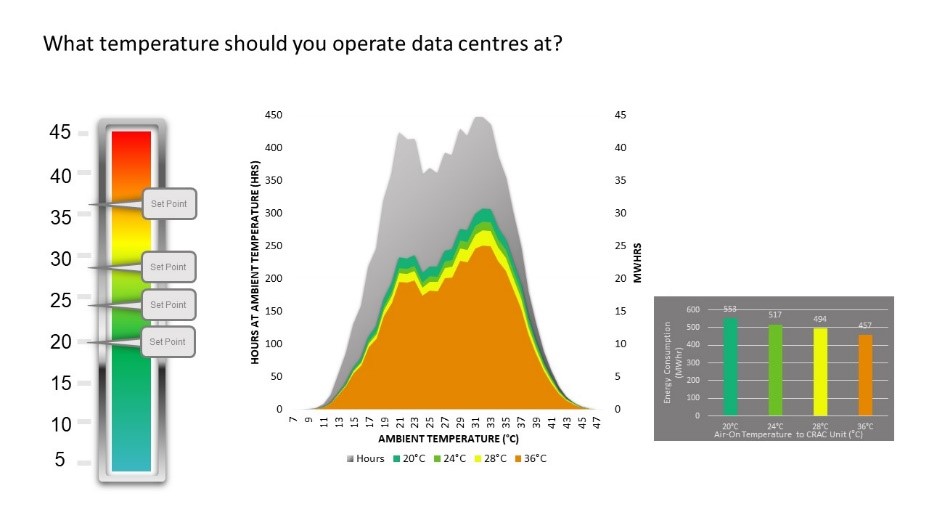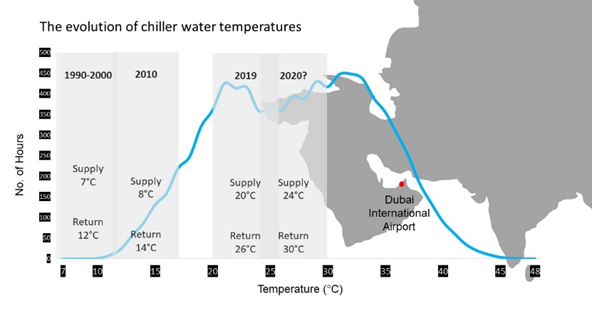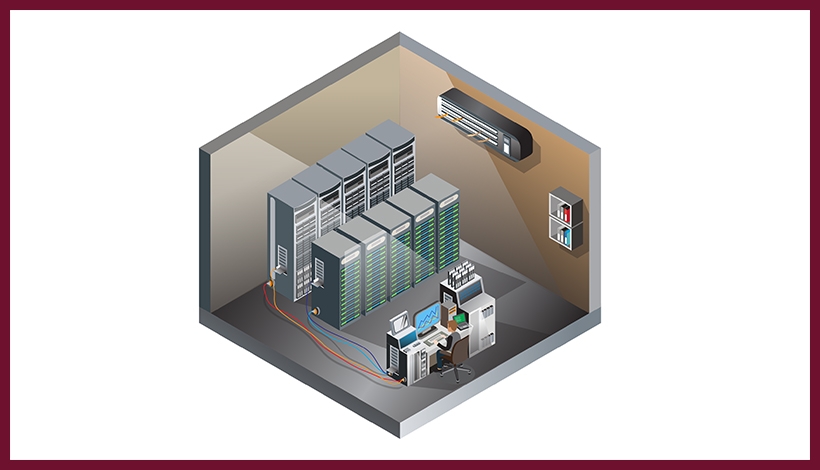Asim Ansari of Airedale International Air Conditioning writes for Eurovent Middle East on the urgent need for more sustainable data centre cooling practices, how to optimise performance in the GCC region, and opportunities for free cooling in high-ambient conditions.

The increasing reliance on data owing to the global community’s rapid digitalisation underscores the fundamental importance of data centres in modern times. The demand is only set to increase as the world steadily moves toward digital processes for many aspects of social, professional, and economic life. However, with this growth comes scrutiny and as data centres become crucial to our way of life, while consuming a greater share of our natural resources, the need for both reliability and sustainability is magnified.
The first, and perhaps most pressing, issue is the impact that such operations have in the context of climate change-mitigation efforts. Mission-critical applications, such as data centres, are known for being energy-intensive, which is potentially detrimental to broader sustainability targets.
The second concern is related to the growing burden of operating cost. The growing energy consumption of more demanding data centres is coming at a time when energy costs are on the rise. This has made operators eager to look for solutions that can help improve the bottom-line, which can come in the form of maximising rack density.
It is important to remember that server cooling accounts for 40-50% of Data Centre energy cost. This means addressing this key issue will be helpful in sustainability measures and profitability. However, the rapid growth of the industry has meant the supply chain has struggled to keep up. Just a few years ago for example, chillers were facing serious issues in the Data Centre sphere as operators required a lot more from their cooling systems than was offered or available on the market. For some time, chiller operating limits and efficiencies were preventing the industry from achieving the PUEs that it strived for and, simply put, past efficiencies were no longer sufficient.
As problems with chillers continued, alternatives like adiabatic dry air coolers were taking advantage of elevated supply air temperatures to provide solutions without the need for compressors. Chillers, at the time, were extremely inflexible, and had relatively limited operating envelopes.
The Middle East dilemma
These typical challenges are especially aggravated in the Middle East. The economic boom in the GCC region attracted international conglomerates and created a need for a reliable digital infrastructure. However, there were a number of complications unique to the region.
As previously mentioned, cooling contributes to a big chunk of the data centre’s energy consumption. The requirement is all the more higher in the Middle East, in view of the high-ambient conditions. The region also sees minimal rainfall and water scarcity, which designers must be mindful of.
There is also greater scope for improvement in terms of raising awareness in the market on better cooling practices within data centres. In the region, conservative temperature management is the norm. There is a habit of maintaining data centres at unnecessarily cool temperatures. In Europe, however, and in many parts of the world, it is common to raise the temperatures as high as possible, in line with updated guidelines on server operating envelopes, to maximise efficiency. There is still a general reluctance in the UAE and GCC region for such an approach, out of unfamiliarity or due to the time lag to catch up with global trends. This is where the industry needs to work together and send a message that raising set points can be key to achieving greater efficiency without compromising on uptime and reliability.
How to optimise data centre performance
Generally, there is a need to drive better understanding of existing references in the market when considering what temperature to operate the data centres. The American Society of Heating, Refrigerating, and Air-conditioning Engineers (ASHRAE) publishes guidelines for temperature and humidity operating ranges of IT equipment (the ASHRAE guidelines cover server inlet air temperatures, not air conditioning discharge temperatures).
The original ASHRAE air temperature recommended envelope for data centers was 20-25 degrees C. This was a conservative statement, based on data available at the time, on how a data center could be reliably operated. Reliability and uptime were the primary concerns and energy costs were secondary. Since then, in-line with technology advancements and a focus on sustainability, ASHRAE have updated their guidelines and now recommend supply temperatures between 18 and 27 degrees C. However, a much wider operating band exists in the “allowable” range, which represent the actual limits at which IT equipment should be subjected to. This gives data centre operators more flexibility in terms of temperature setting, with the caveat that outside the recommended range, there is an expected impact on reliability, defined as the “X Factor”.
Typical failure rates for IT equipment are low, around 2-4% annually. According to updated ASHRAE calculations, operating at the top of the allowable range (45°C) would only increase the failure rate by an additional 3-7%.
In Figure 1 and Figure 2, we present studies conducted on the savings that can be achieved from raising the temperature in stages using an annual temperature profile for Dubai.

Figure 1: Based on a 200kW DC, 5 x CRAC units

Figure 2: Energy savings summary
- 20 degrees C, 24 degrees C, 28 degrees C and 36 degrees C.
- Raising the Air-On temperatures to the CRAC unit reduces energy consumption.
- Typical cost savings of $10,000 USD per year can be achieved.
Consider the possibilities
With raised temperatures, the possibility of introducing a degree of free cooling is now realised; previously a pipe dream in hot regions. Going back to my previous comment on chillers, earlier chiller designs and system applications were not taking full advantage of free cooling opportunities, and this lack of system optimisation led to further energy wastage. In free-cooling operation, up until recently, typical approach temperatures were wide, resulting in low supply water temperatures, which had a significant impact on energy usage.
Higher data centre temperatures, coupled with a new generation of thinking around chillers and free cooling systems, where approach temperatures are narrow and Delta Ts are wide, means that free-cooling can be achieved even in higher ambient regions such as the Middle East.
Redesigning free cooling coils, simplifying air paths, increasing coil surface area, ducting hot air directly to the CRAC units and unifying indoor and outdoor equipment with intelligent software systems, are all factors of these optimised systems that have allowed Airedale to take advantage of evolving temperatures to maximise free cooling and save energy.
Its potential to be used even in high-ambient conditions has also been proven. We have had experience in the design of free cooling systems in high ambient regions and believe this could be achieved in the Gulf.

Figure 3: Free Cooling Opportunity with raised Chilled Water temperatures

Figure 4: Trend of Raising Chilled Water temperatures in the DC environment
We believe there is strong potential for concurrent cooling for data centres in the Gulf region, which sees the hybrid operation of a chiller’s mechanical operation and free cooling design working in tandem.
Without a doubt, there are great benefits that can be achieved in the use of concurrent cooling, especially in terms of energy efficiency and sustainability. However, at the moment, in view of the GCC region’s relatively low energy prices, the extra cost required to switch from a standard chiller to a free cooling chiller might not be able to justify the extra initial cost. However, the technology and solutions are very much available to stakeholders in the Middle East, and with the global energy prices on the rise it could be a good opportunity for stakeholders to stay ahead of the curve and future proof their operations from rising energy costs.
Another helpful approach to achieving energy savings and impressive Power Usage Effectiveness metrics is through the use of intelligent controls systems. Essentially, an optimised HVAC is the harmonisation of the equipment with the environment and a combination of unit controls and building controls can ensure HVAC systems run effectively at their most efficient operating settings.
Working for a more sustainable future
With the increase in number of co-location data centres, as well as the roll-out of 5G, data centre operators will have to adapt better efficiency standards to meet customer demand. Overall, I believe there has been a significant improvement in the Middle East in terms of embracing best standards of education and there has also been more influence from the data centre industry in the global scale. The knowledge shared from experts working in other parts of the world has influenced temperatures and improved working practices.
However, we need to work together to create a positive shift in mindsets and move away from traditional approaches. This highlights the importance of platforms, such as Eurovent Middle East. It is our responsibility, as an industry, to develop communication aimed at sharing best practices that will be helpful to all relevant stakeholders. This includes informing the manager of a data centre that raising the temperature is a more environmentally friendly approach, helping consultants become acquainted with the latest technology in the market, and educating the public sector to raise federal government standards.
As the data centre industry grows, so does its demand on the planet’s natural resources, including power and water, and as cooling systems and techniques evolve, there is an opportunity for data centre operators in this region not only to save money but also play a greater role in conserving our natural resources.
